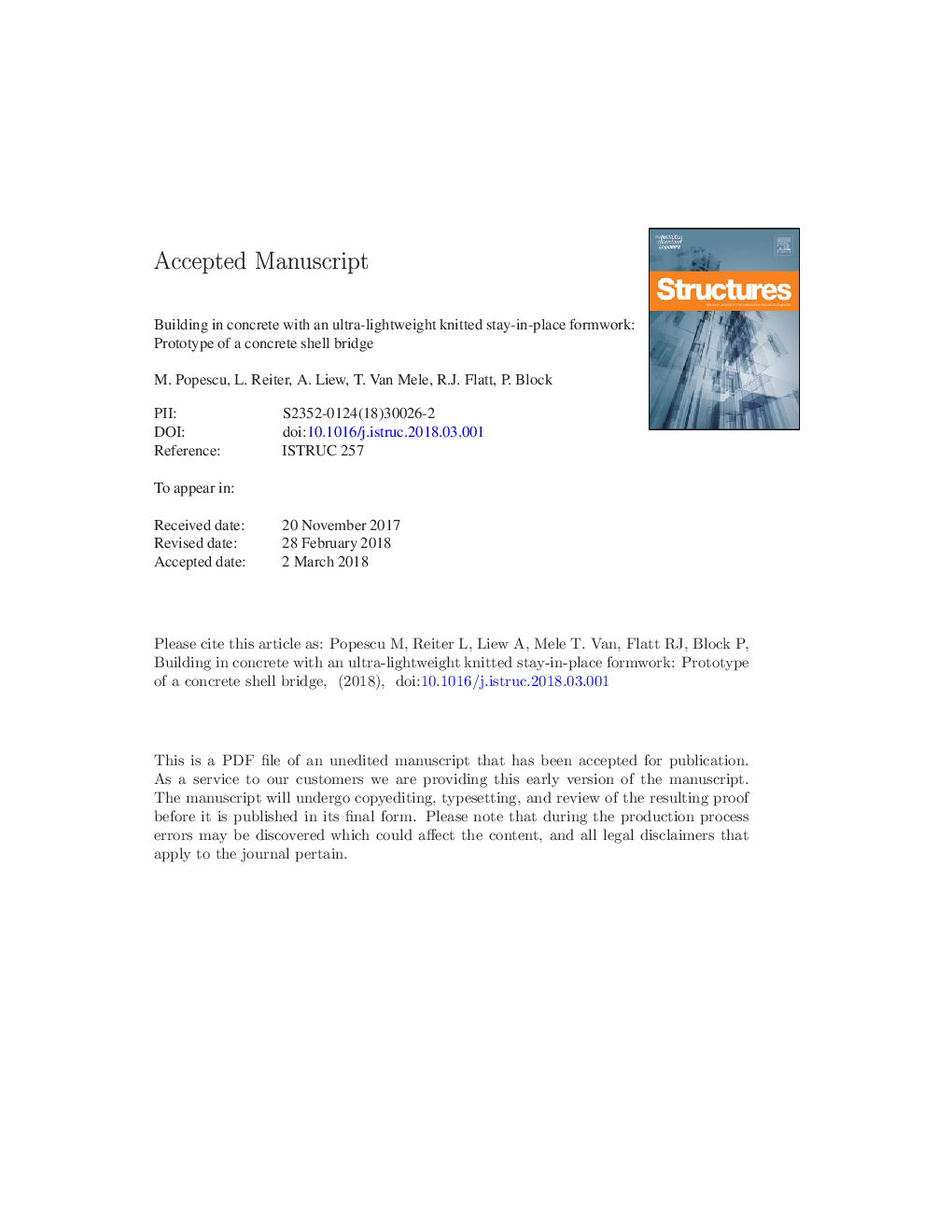| کد مقاله | کد نشریه | سال انتشار | مقاله انگلیسی | نسخه تمام متن |
|---|---|---|---|---|
| 6774571 | 1431993 | 2018 | 13 صفحه PDF | دانلود رایگان |
عنوان انگلیسی مقاله ISI
Building in Concrete with an Ultra-lightweight Knitted Stay-in-place Formwork: Prototype of a Concrete Shell Bridge
ترجمه فارسی عنوان
ساخت و ساز در بتن با یک فرمول مجهز به مضرب فوق العاده سبک بافتنی: نمونه اولیه پل تک بتن
دانلود مقاله + سفارش ترجمه
دانلود مقاله ISI انگلیسی
رایگان برای ایرانیان
کلمات کلیدی
بافتنی بافتنی نساجی، قالب مونتاژ در محل، ترکیبی، خم شدن فعال، سیمان، پوشش لایه لایه بتن،
ترجمه چکیده
یک سیستم قالب بندی جدید به عنوان صرفه جویی در مواد، کاهش کار و راه حل مقرون به صرفه برای ریخته گری از هندسه دو طرفه منحنی بتن قرار داده شده ارائه شده است. این رویکرد از یک پارچه نساجی بافتنی سفارشی استفاده می کند که به عنوان یک فرمول سبک اقامت در محل با راه حل های یکپارچه برای قرار دادن عناصر اضافی، و به عنوان یک پارچه تقریبا بدون درز ساخته شده است. با استفاده از بافندگی بافندگی به عنوان تکنیک تشکیل نساجی، نیاز به برش الگوها، دوختن، جوشکاری یا چسباندن، در مقایسه با بافندگی معمولی امکان پذیر می شود و امکان کانتینرها، دهانه ها، عرض های مختلف و خواص مواد جهت دارد، بنابراین فضای طراحی هندسی گسترش می یابد . این سیستم از طریق نمونه اولیه پایینی بتن سبک، ساخته شده با استفاده از نساجی نساجی با ترکیبی از قبل از تنش و یک ساختار خمشی فعال که به عنوان قالب بندی بدون چسب و بدون ماندگاری عمل می کند، آزمایش شده است. از طریق ایجاد تدریجی قدرت در لایه های نازک بتن، تغییر شکل قالب در هنگام ریخته گری به حداقل می رسد. این امر موجب کاهش سطوح کشش پارچه و امکان استفاده از فشار بالا (به عنوان مثال در هنگام شلاق زدن) در استفاده از بتن بعدی بدون پشتیبانی متوسط از پایین است. طراحی محاسباتی و ساخت قالب نساجی نسوجی شامل کانال های یکپارچه برای قرار دادن میله های خم فعال، نوارهای کشش و ویژگی های کنترل ریخته گری بتن. تجزیه و تحلیل و روند افزایش سفتی فرمول سبک و قابل انعطاف ارائه شده است. این روش ترکیبی به یک قالب بسیار سبک وزن تبدیل می شود که به راحتی قابل حمل می باشد و به طور قابل توجهی نیازمند پشتیبانی نرده ها و داربست ها است که مزایای بسیاری در محل ساخت و ساز دارد.
موضوعات مرتبط
مهندسی و علوم پایه
سایر رشته های مهندسی
مهندسی عمران و سازه
چکیده انگلیسی
A novel formwork system is presented as a material saving, labour reducing and cost-effective solution for the casting of bespoke doubly curved concrete geometries. The approach uses a custom knit technical textile as a lightweight stay-in-place formwork with integrated solutions for the insertion of additional elements, and is fabricated as a nearly seamless fabric. Using weft knitting as the textile formation technique minimises the need for cutting patterns, sewing, welding or gluing, when compared to conventional weaving and gives the possibility to integrate channels, openings, have varying widths and directional material properties, thus broadening the geometric design space. The system has been tested through a small-scale concrete footbridge prototype, built using a pre-stressed hybrid knitted textile and a bending-active structure that acted as a waste-free, stay-in-place, self-supporting formwork. Through the gradual buildup of strength in thin layers of concrete, formwork deformations during casting were minimised. This allowed for low tensioning levels of the fabric and the possibility to use higher pressure (e.g. during shotcreting) in applying the subsequent concrete without intermediate support from below. The computational design and fabrication of the knitted textile formwork included integrated channels for the insertion of bending-active rods, tensioning ribbons and features for controlling the concrete casting. The analysis and process of increasing the stiffness of the lightweight and flexible formwork is presented. The hybrid approach results in an ultra-lightweight formwork that is easily transportable and significantly reduces the need for falsework support and scaffolding, which has many advantages on the construction site.
ناشر
Database: Elsevier - ScienceDirect (ساینس دایرکت)
Journal: Structures - Volume 14, June 2018, Pages 322-332
Journal: Structures - Volume 14, June 2018, Pages 322-332
نویسندگان
M. Popescu, L. Reiter, A. Liew, T. Van Mele, R.J. Flatt, P. Block,
